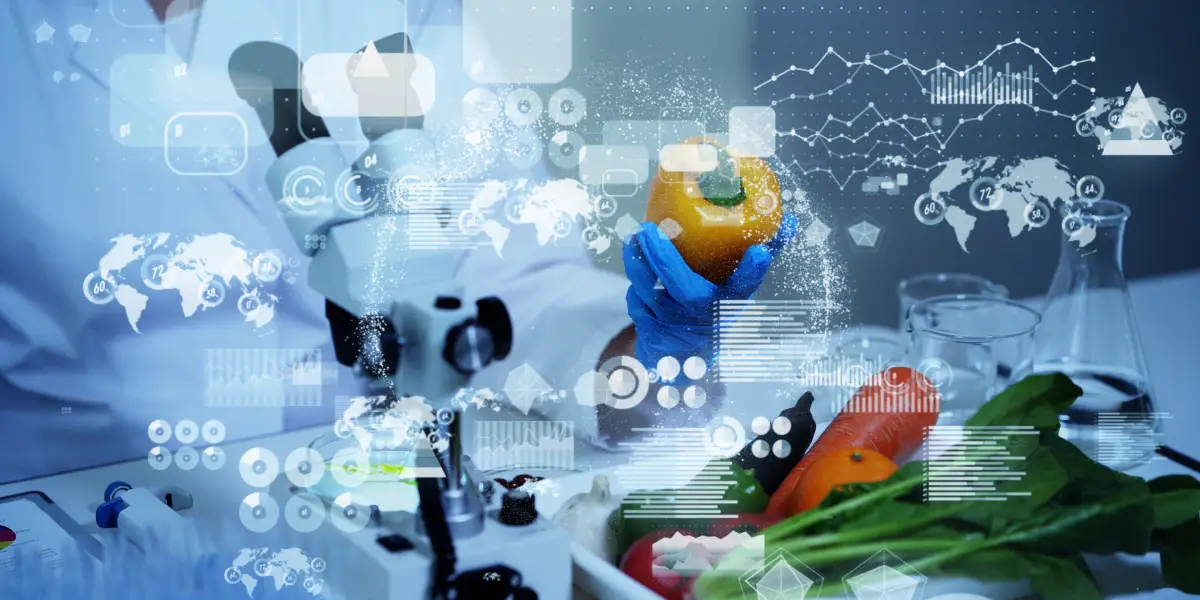
From farm to table, digital technology has been pivotal in transforming the food and agriculture industry worldwide as digitalization changes every aspect of the food supply chain, revolutionizing the way we produce, distribute, and consume food. Here, we’ll explore how digital technology is transforming the food industry and what are the latest trends driving this culinary revolution.
1. Precision Agriculture: Cultivating the Future
It all begins on the farm, and digital technology has significantly altered the way we approach agriculture. Precision agriculture, enabled by sensors, drones, AI and IoT devices, has empowered farmers with real-time data on soil conditions, weather patterns, and crop health. This data-driven approach optimizes farming practices, leading to increased yields, reduced waste, and sustainable farming.
2. Smart Supply Chains: From Field to Fork
The integration of digital technology in supply chain management has revolutionized the food industry’s logistics. Blockchain technology is being employed to create transparent and traceable supply chains, ensuring the authenticity and safety of food products. This not only helps in identifying and addressing potential issues promptly but also builds trust among consumers who are becoming increasingly concerned about the origins of their food.
3. Online Food Delivery and Virtual Restaurants
The rise of online food delivery platforms has changed the way we experience dining. The convenience of ordering food with a few taps on a smartphone has led to a surge in the popularity of food delivery services. Moreover, the emergence of virtual restaurants, which operate exclusively through these platforms, is challenging traditional brick-and-mortar establishments. These virtual kitchens focus on specific cuisines or dishes, catering to niche markets with agility and efficiency.
4. AI and Personalized Nutrition
Artificial Intelligence (AI) is making significant strides in the food industry, particularly in personalized nutrition. Apps and platforms leverage AI algorithms to analyze individual dietary habits, health conditions, and preferences, providing personalized dietary recommendations. This aids consumers in making healthier choices as well as allow food businesses to tailor their offerings to meet the diverse needs of their customers.
5. Augmented Reality (AR) Dining Experiences
Digital technology and dining experiences are exemplified by the coming of Augmented Reality (AR). Restaurants are incorporating AR to enhance the dining experience, offering interactive menus, virtual food tastings, and immersive storytelling about the origins of the ingredients. This adds an element of entertainment plus, elevates the overall dining experience for patrons.
6. Sustainability and Food Tech
Concerns about environmental sustainability have prompted the food industry to explore innovative solutions. Plant-based alternatives, lab-grown meat, and sustainable packaging are gaining traction. Technology plays a pivotal role in the development and popularization of these alternatives, providing consumers with environmentally friendly choices that align with their values.
6. Robotics in Food Preparation
The convergence of robotics in the kitchen is streamlining food preparation processes. From automated cooking and chopping to robotic assembly lines, these technologies enhance efficiency, reduce labor costs, and maintain consistency in food quality. While human expertise remains irreplaceable in many aspects of culinary art, robotics contribute to a more streamlined and efficient food production process.
7. Data Analytics for Consumer Insights
The collection and analysis of consumer data have become invaluable for food businesses. Through loyalty programs, mobile apps, and online interactions, companies can gather data on consumer preferences, purchasing behavior, and feedback. This information is then analyzed to identify trends, allowing businesses to tailor their products, marketing strategies, and even pricing to better meet consumer demands.
9. Digital Menu Boards and Point-of-Sale Systems
Traditional printed menus are making way for digital menu boards in many restaurants. These dynamic displays allow for easy updates and customization, enabling the integration of multimedia elements, such as images and videos showcasing dishes. Furthermore, advanced point-of-sale (POS) systems enhance the efficiency of order processing, inventory management, and customer service, streamlining restaurant operations.
10. 3D Printing in Food
The intersection of technology and culinary arts has given rise to 3D printing in the food industry. From sophisticated chocolate sculptures to customized pasta shapes, 3D printing allows chefs to unleash their creativity and offer unique, visually stunning dishes. Beyond aesthetics, 3D printing also has the potential to revolutionize food customization and nutritional content.
11. Voice-Activated Kitchen Assistants
Voice-activated virtual assistants like Amazon’s Alexa or Google Assistant are finding their way into kitchens. These devices can help users with recipe recommendations, cooking instructions, and even create shopping lists based on verbal commands. The hands-free operation makes them particularly useful for busy home cooks.
12. Blockchain for Food Safety
Foodborne illnesses and contamination are an ongoing concern. Blockchain technology provides an immutable and transparent ledger, allowing every step of the food supply chain to be recorded. This ensures accountability, traceability, and quick identification of the source in case of a food safety issue, ultimately bolstering consumer confidence.
13. Augmented Reality (AR) for Grocery Shopping
AR isn’t limited to restaurants; it’s also enhancing the grocery shopping experience. Some applications allow users to point their smartphones at products on the shelf, providing detailed information about nutritional content, sourcing, and even recipe suggestions. This technology bridges the gap between the online and offline shopping experience.
14. Smart Packaging
The packaging of food products is undergoing major digital transformation. Smart packaging incorporates technologies like QR codes, NFC (Near Field Communication), and RFID (Radio-Frequency Identification) to provide consumers with information about the product’s origin, expiration date, and even interactive content. This not only enhances consumer engagement but also contributes to reducing food waste by conveying real-time freshness status.
15. Biometrics in Restaurants
Biometric technology is making its way into the restaurant industry for enhanced security and convenience. Facial recognition or fingerprint scanning can be used for secure payment transactions, loyalty program identification, and even personalized dining experiences, streamlining the customer journey.
As technology continues to advance, we can expect even more innovative solutions that will further reshape how we produce, distribute, and enjoy food in the years to come. The influence of digital technology is omnipresent, offering new possibilities and addressing age-old challenges. Embracing these technological advancements not only ensures the industry’s competitiveness but also paves the way for a more sustainable, transparent, and personalized future in the world of food.
References:
